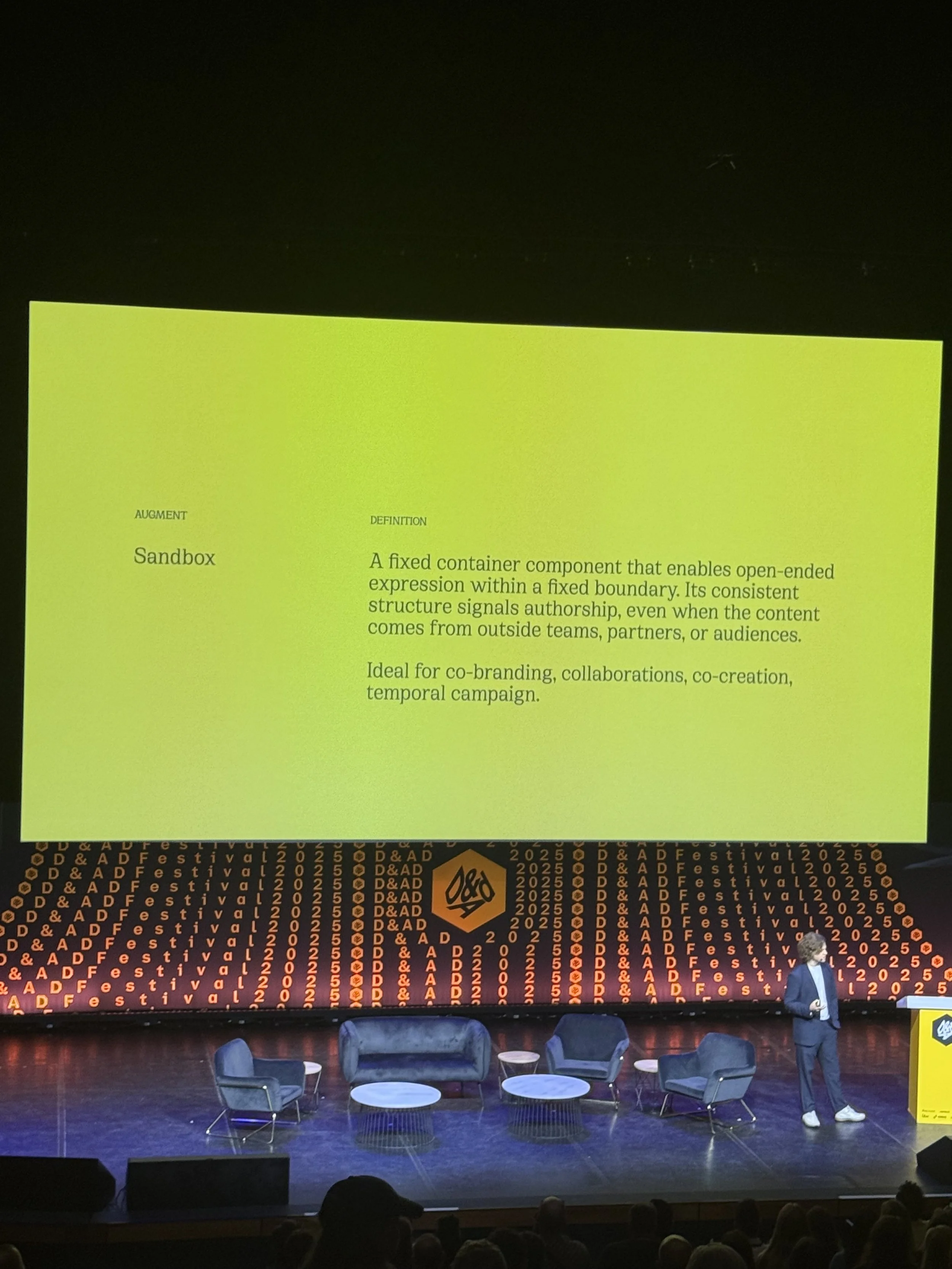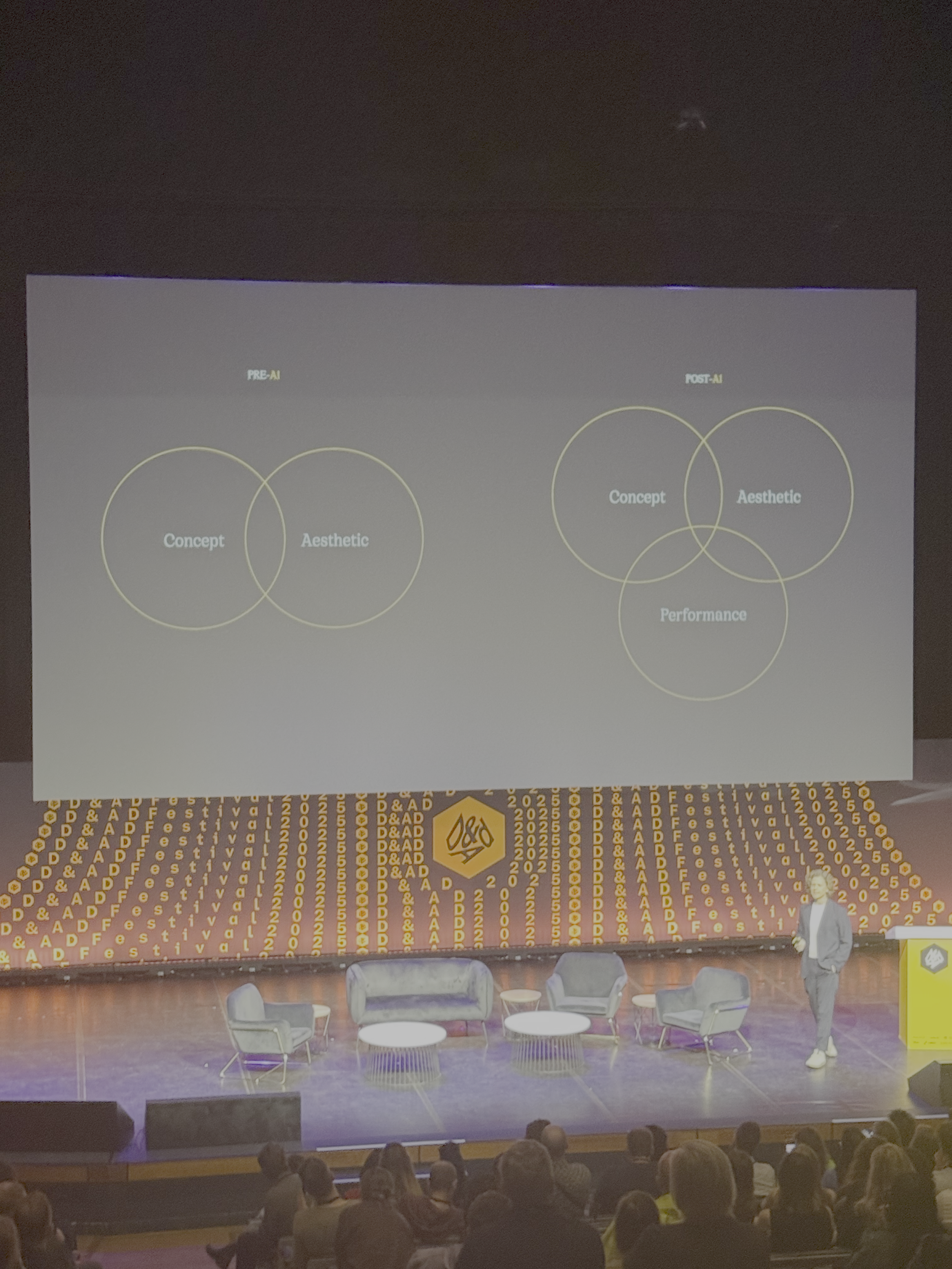Revolution vs Brand Identity: Leland Maschmeyer’s “Perform or Perish” Rocks D&AD 2025 South Bank—How Designers Can Augment, Perform & Thrive
South Bank isn’t a venue, it’s a concrete war-cry. Festival Hall glints noble on one side, the National Theatre crouches like a brutalist beast on the other, and beneath them the undercroft rattles with skaters nose-grinding through neon graffiti. That’s the soundtrack to Day 1 of D&AD 2025—a perfect place to ask whether design survives the AI tidal wave or gets ground into the Thames-silt.
I packed eleven sessions into yesterday’s schedule, but one burned brighter than the rest—so electric it felt like a fresh gospel begging to be passed along the minute I hit the hallway.
I thought leaving agency life would detox me from my obsession with brand identity. No chance. You can yank the boy out of the studio, but the gridlines and colour swatches still glow in the bloodstream—and that’s why Leland Maschmeyer’s session “Perform or Perish” felt like a personal call-out. The COLLINS co-founder stepped onto the stage, looked out over several hundred designers clutching lanyards and flat whites, and made it plain: this is our quartz moment.
A Brief Detour to 1969
When Seiko released the Astron quartz watch on Christmas Eve of ’69, centuries of Swiss craft were rendered quaint overnight. Accuracy moved from ±6 seconds a day to ±0.2 seconds, production costs fell off a cliff, and suddenly the thing everyone sold—keeping time—was basically free. Most Swiss makers folded. The survivors did something counter-intuitive: they doubled down on features nobody strictly needed. Tourbillons, moon-phase dials, perpetual calendars—‘complications’ so elegant and unnecessary that they turned timekeeping into theatre. Precision got commoditised; performance became priceless.
Maschmeyer’s point landed cleanly: AI is our quartz crystal. A mid-tier laptop, a subscription prompt-engine, and a YouTube tutorial can now spit out work that looks serviceable. RFPs arrive with a 17× spread between the cheapest and most expensive proposal for the same brief because clients can’t tell where the real value hides. If design stays framed as visual polish, the game is over. But if we shift the conversation from beauty to behaviour, from craft to capability, we get to write the next chapter.
“It doesn't matter that AI is here. It doesn't matter that it's going to disrupt and change the rules of everything. What matters is how we respond. And like with Swiss watchmakers, the value that we have is already here. We just have to surface it. We have to make it understandable with language.”
The Value Vanishing Act
The slide in design’s perceived value is almost entirely technology-driven. Today, the cost of entry hovers near zero: a half-decent laptop and increasingly powerful software can turn once-specialised tasks into point-and-click routines. That democratisation floods the field with competent work, and the sophistication of modern tools has narrowed the visible gap between veteran and newcomer. From a client’s vantage point, proposals begin to look interchangeable, so decisions default to speed and price. Design slips from “strategic partner” to “commodity purchase”, judged on how quickly and cheaply it can be delivered. AI is set to amplify this effect—churning out respectable visuals in seconds—unless designers make their thinking explicit and prove the long-term value that smart, human strategy still brings.
Augments: Design’s New Power Moves
Maschmeyer’s thesis: where watchmakers invented complications, designers must develop what Collins calls augments—strategic modules welded onto identity systems that make them do something. Maschmeyer broke it down into a few key examples:
Sandbox frameworks that let a brand express itself a thousand ways without splintering.
Content-integration adapters so third-party assets drop into the system like new organs into a living body.
Navigational colour that doesn’t just delight, it guides, sorts, warns, calms.
Structural grid innovations that ensure every expression is on-brand even when produced at speed by people who’ve never read the guidelines.
When those pieces click, the logo isn’t a badge; it’s the front end of a performance engine.
Redefining Value, One Word at a Time
The dirty secret of pricing is perception. Swiss makers didn’t add gemstones to justify five-figure tags; they added stories about mastery, rarity, human impossibility. Design needs its own language shift. We retire the talk of “look and feel” and start naming the things only seasoned designers can coax into existence: signal clarity, adaptive cohesion, revenue resilience. If procurement can’t pronounce it, procurement can’t commoditise it.
Wittgenstein warned that the limits of our language are the limits of our world. In 2025 the corollary is obvious: the limits of our language are the limits of our fee. Clients pay for what they can articulate. So we teach them new words, then deliver work that proves those words were necessary.
It doesn't matter that AI is here. It doesn't matter that it's going to disrupt and change the rules of everything. What matters is how we respond. And like with Swiss watchmakers, the value that we have is already here. We just have to surface it. We have to make it understandable with language:
“And so I urge all of us to find new language to express the performance features of what we do, because that is what's going to matter going forward. When aesthetics becomes cheap, when iteration becomes so fast that clients don't know where to place the value anymore … we must focus on the idea of performance, which we've always done before, but it's now time for us to get credit for it.”
A Working Blueprint
Maschmeyer’s close read of the AI landscape never slipped into doom. Instead, he handed out a survival manual disguised as an invitation:
Let the machines draft; let humans decide. AI is brilliant at speed and breadth, terrible at judgement. Use it to surface extremes, anomalies, and half-ideas. Then step in with taste.
Measure everything. If a colour system reduces user error by 12%, that’s a headline, not a footnote.
Make R&D non-negotiable. Swiss brands drop limited editions every year to keep the myth alive. Agencies should budget for continuous upgrades—new gestures, new plug-ins, new tests.
Broadcast the process, not just the polish. People trust what they can watch being made. Post sketches, prototypes, false starts. It builds the only commodity AI can’t fake: authenticity born of effort.
Standing in the foyer after the talk, with skaters rattling somewhere below and the Thames hissing beyond the glass, I realised how liberating the challenge feels. AI has taken the cost of entry down to zero and, in doing so, cleared the space for designers to climb higher on the value ladder. The path up is paved with systems that perform, stories that shift perspective, and language that reframes what’s at stake.
Five Rebel Rules for the Post-AI Designer
Ride the Terror. Treat AI like a 120 bpm half-pipe: bruises guaranteed, but you’ll clear gaps humans can’t jump alone.
Metric-ise the Magic. If it doesn’t move a needle—traffic, dwell, retention—kill it or retrofit it.
Forge a Lexicon Procurement Can’t Pronounce. “Dynamic Parametric Identity Lattice™”. Makes the CFO sweat? Good.
Proprietary or Die. Build frameworks with undocumented switches. If a competitor can Ctrl-C it, you built a commodity.
Stay Principle-Rich, Tool-Agnostic. Your compass is creativity; your weapons cache refreshes nightly.
Take what you need, leave the rest on the riverbank, and remember: the Thames keeps rolling, the briefs keep arriving, and the only work that counts from here on out is the work that performs.




